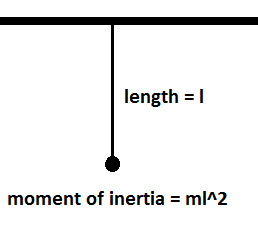We know that the change in mass does not affect the time period of a pendulum. Will a change in the location of the center of mass of the bob affect the time period?
-
$\begingroup$ Position of the centre of mass changes means lenght of the pendulum changes which does impact the time period $\endgroup$– PaulCommented Feb 24, 2017 at 7:49
-
$\begingroup$ Related: physics.stackexchange.com/q/80287/25301 $\endgroup$– Kyle KanosCommented Feb 24, 2017 at 11:23
2 Answers
The length of pendulum is the distance from the point of suspension to the centre of mass of Bob. So if you change the centre of mass the length of pendulum would be affected affecting the time period
Let us take a general case where an object $O$ is oscillating from a fixed point $P$.
- $C$ is the center of mass of the object $O$.
- $P$ is the pivot point about which the object rotates (axis-of-rotation).
$N$ is the normal force exerted on the object $O$ by the pivot $P$. $$$$
Let the moment of inertia of the object $O$ be $I$.
- Let the distance between the point $P$ and point $C$ be $l$ (distance between the center of mass $C$ and the pivot $P$).
$$$$
We can write the torque equation for the object $O$ about the point $P$. The only forces which are acting on the object are the normal force ($N$) and the gravitational force ($mg$). Since the normal force $N$ is acting on the pivot, the torque due it is zero. Therefore, only gravitational force provides the torque.
$$\vec{\tau} = \vec{l} \times m\vec{g} \tag{1}$$
$$\tau = I\alpha = -mgl \sin\theta \tag{2}$$
The negative sign appears as the torque always tries to reduce the angle $\theta$.
Simplifying equation $(2)$ further, you get:
$$\frac{d^2 \theta}{dt^2} = -\frac{mgl}{I} \sin\theta \tag{3}$$
For small angles of $\theta$, the following approximation holds:
$$\sin \theta \approx \theta \tag{4}$$
Using $(4)$, you can rewrite $(3)$ as
$$\frac{d^2 \theta}{dt^2} = -\frac{mgl}{I} \theta \tag{5}$$
The general equation for a quantity $\phi$ varying harmonically without damping is given by:
$$\frac{d^2\phi}{dt^2} = - \omega^2\phi \tag{6}$$
If you observe carefully, the equation $(5)$ is similar to equation $(6)$. Comparing the two equations, you get:
$$\omega^2 = \frac{mgl}{I}$$
$$\omega = \sqrt{\frac{mgl}{I}} \tag{7}$$
As you already know, the time period is related to $\omega$ as: $$T = \frac{2\pi}{\omega} \tag{8}$$
Substituting $\omega$ from $(7)$ in equation $(8)$, you get
$$T = 2\pi \sqrt{\frac{I}{mgl}} \tag{9}$$
The above equation gives the time period for any object oscillating harmonically without damping with small amplitudes.
A pendulum is just a special case of the above generalization.
Substiuting the values for the variables in equation $(9)$, you get:
$$T = 2\pi \sqrt{\frac{ml^2}{mgl}}$$
$$T = 2\pi \sqrt{\frac{l}{g}}$$
As you have seen in the derivation, $l$ is the distance between the pivot $P$ and the center of mass of the rotating object $O$. Therefore, moving the center of mass effectively changes the distance between the center of mass and the pivot. This causes a change in time period.



